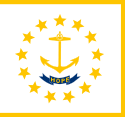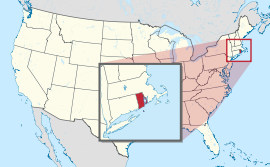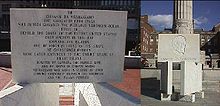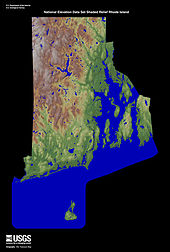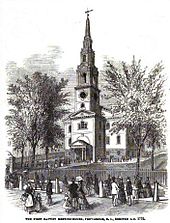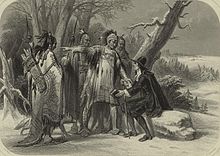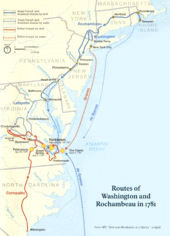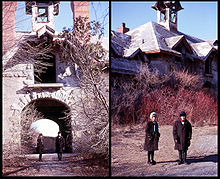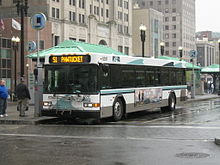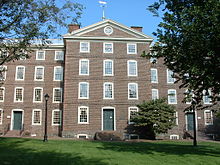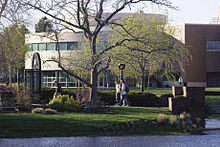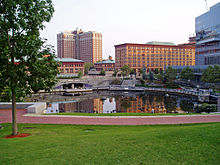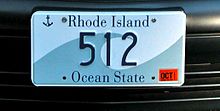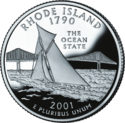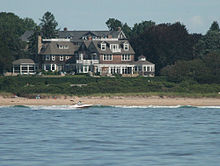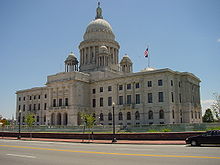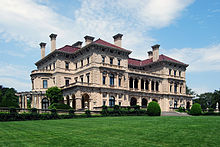
Rhode Island
Did you know...
This Wikipedia selection is available offline from SOS Children for distribution in the developing world. To compare sponsorship charities this is the best sponsorship link.
| State of Rhode Island and Providence Plantations | |||||
|
|||||
| Nickname(s): The Ocean State Little Rhody |
|||||
| Motto(s): Hope | |||||
| Official language(s) | De jure: None De facto: English |
||||
| Demonym | Rhode Islander | ||||
| Capital ( and largest city) |
Providence | ||||
| Area | Ranked 50th in the U.S. | ||||
| - Total | 1,214 sq mi (3,140 km2) |
||||
| - Width | 37 miles (60 km) | ||||
| - Length | 48 miles (77 km) | ||||
| - % water | 13.9% | ||||
| - Latitude | 41° 09' N to 42° 01' N | ||||
| - Longitude | 71° 07' W to 71° 53' W | ||||
| Population | Ranked 43rd in the U.S. | ||||
| - Total | 1,050,292 (2012 est.) | ||||
| - Density | 1006/sq mi (388/km2) Ranked 2nd in the U.S. |
||||
| - Median household income | $54,619 (16th) | ||||
| Elevation | |||||
| - Highest point | Jerimoth Hill 812 ft (247 m) |
||||
| - Mean | 200 ft (60 m) | ||||
| - Lowest point | Atlantic Ocean sea level |
||||
| Before statehood | Rhode Island | ||||
| Admission to Union | May 29, 1790 (13th) | ||||
| Governor | Lincoln Chafee (I) | ||||
| Lieutenant Governor | Elizabeth H. Roberts (D) | ||||
| Legislature | General Assembly | ||||
| - Upper house | Senate | ||||
| - Lower house | House of Representatives | ||||
| U.S. Senators | Jack Reed (D) Sheldon Whitehouse (D) |
||||
| U.S. House delegation | 1: David Cicilline (D) 2: James Langevin (D) ( list) |
||||
| Time zone | Eastern: UTC -5/ -4 | ||||
| Abbreviations | RI US-RI | ||||
| Website | www.ri.gov | ||||
| Footnotes: * Total area is approximately 776,957 acres (3,144 km2) | |||||
Rhode Island ( / ˌ r oʊ d ˈ aɪ l ɨ n d / or / r ɵ ˈ d aɪ l ɨ n d /), officially the State of Rhode Island and Providence Plantations, is a state in the New England region of the United States. Rhode Island is the smallest in area, the eighth least populous, but the second most densely populated of the 50 US states behind New Jersey. Rhode Island is bordered by Connecticut to the west and Massachusetts to the north and east, and it shares a water boundary with New York's Long Island to the southwest.
Rhode Island was the first of the 13 original colonies to declare independence from British rule, declaring itself independent on May 4, 1776, two months before any other colony. The State was also the last of the thirteen original colonies to ratify the United States Constitution.
Rhode Island's official nickname is "The Ocean State", a reference to the State's geography, since Rhode Island has several large bays and inlets that amount to about 14% of its total area. Its land area is 1,045 square miles (2,710 km2), but its total area is significantly larger.
Origin of the name
Despite the name, most of Rhode Island is on the mainland United States. The official name of the state, Rhode Island and Providence Plantations, derives from the merger of two settlements. Rhode Island colony was founded near present-day Newport, on what is now commonly called Aquidneck Island, the largest of several islands in Narragansett Bay. Providence Plantations was the name of the colony founded by Roger Williams in the area now known as the City of Providence.
It is unclear how Aquidneck Island came to be known as Rhode Island, although there are two popular theories.
- The explorer Giovanni da Verrazzano, in 1524 noted the presence of an island near the mouth of Narragansett Bay, which he likened to the Greek island of Rhodes. Subsequent European explorers were unable to precisely identify the island that Verrazzano had named. The Pilgrims who later colonized the area assumed that Verrazzano's "Rhodes" was Aquidneck.
- A second theory concerns the fact that Adriaen Block, during his expeditions in the 1610s, passed by Aquidneck, described in a 1625 account of his travels as "an island of reddish appearance" (in 17th-century Dutch, "een rodlich Eylande"). Historians have theorized that this "reddish appearance" resulted from either red autumn foliage or red clay on portions of the shore.
The earliest documented use of the name "Rhode Island" for Aquidneck was in 1637, by Roger Williams. The name was officially applied to the island in 1644 with these words: "Aquethneck shall be henceforth called the Isle of Rodes or Rhode-Island." The name "Isle of Rodes" is found used in a legal document as late as 1646. Dutch maps as late as 1659 call the island "Red Island" (Roodt Eylant).
Roger Williams was a theologian forced out of the Massachusetts Bay Colony. Seeking religious and political tolerance, he and others founded " Providence Plantations" as a free proprietary colony. "Providence" referred to the divine providence and "plantations" referred to an English term for a colony.
"Rhode Island and Providence Plantations" is the longest official name of any state in the Union. On June 25, 2009, the General Assembly voted to allow the people to decide whether to keep the name or drop "and Providence Plantations" due to the misperception that the name relate to slavery. The referendum election was held on this subject during the November 2, 2010 elections, and the people overwhelmingly (78% to 22%) voted to keep the original name.
Geography
Rhode Island covers an area of 1,214 square miles (3,140 km2) and is bordered on the north and east by Massachusetts, on the west by Connecticut, and on the south by Rhode Island Sound and the Atlantic Ocean. It shares a narrow maritime border with New York State between Block Island and Long Island. The mean elevation of the state is 200 feet (60 m).
Nicknamed the Ocean State, Rhode Island has a number of oceanfront beaches. It is mostly flat with no real mountains, and the state's highest natural point is Jerimoth Hill, 812 feet (247 m) above sea level.
Located within the New England province of the Appalachian Region, Rhode Island has two distinct natural regions. Eastern Rhode Island contains the lowlands of the Narragansett Bay, while Western Rhode Island forms part of the New England Upland. Rhode Island's forests are part of the Northeastern coastal forests ecoregion.
Narragansett Bay is a major feature of the state's topography. Block Island lies approximately 12 miles (19 km) off the southern coast of the mainland. Within the Bay, there are over 30 islands. The largest is Aquidneck Island, shared by the municipalities of Newport, Middletown, and Portsmouth. The second-largest island is Conanicut; the third-largest is Prudence.
Geology
A rare type of rock called Cumberlandite, found only in Rhode Island (specifically in the town of Cumberland), is the state rock. There were initially two known deposits of the mineral, but since it is an ore of iron, one of the deposits was extensively mined for its ferrous content. The state is underlain by the Avalon terrane and was once part of the micro-continent Avalonia prior to closure of the Iapetus ocean.
Climate
Rhode Island is an example of a humid continental climate with warm, rainy summers and chilly winters. The highest temperature recorded in Rhode Island was 104 °F (40 °C), recorded on August 2, 1975, in Providence. The lowest recorded temperature in Rhode Island was −23 °F (−31 °C), on February 5, 1996, in Greene. Monthly average temperatures range from a high of 83 °F (28 °C) to a low of 20 °F (−7 °C).
History
Colonial era: 1636–1770
In 1636, Roger Williams, after being banished from the Massachusetts Bay Colony for his religious views, settled at the tip of Narragansett Bay, on land granted to him by the Narragansett and Pequot tribes. Both tribes were subservient to the Wampanoag tribe led by Massasoit. He called the site Providence "having a sense of God's merciful providence unto me in my distress." Eventually it became a place of religious freedom.
In 1638, after conferring with Williams, Anne Hutchinson, William Coddington, John Clarke, Philip Sherman, and other religious dissidents settled on Aquidneck Island (then known as Rhode Island), which was purchased from the local natives, who called it Pocasset. This settlement was called Portsmouth and was governed by the Portsmouth Compact. The southern part of the island became the separate settlement of Newport after disagreements among the founders.
Samuel Gorton purchased the Native American lands at Shawomet in 1642, precipitating a military dispute with the Massachusetts Bay Colony. In 1644, Providence, Portsmouth, and Newport united for their common independence as the Colony of Rhode Island and Providence Plantations, governed by an elected council and "president". Gorton received a separate charter for his settlement in 1648, which he named Warwick after his patron.
During King Philip's War (1675–1676), a force of Massachusetts, Connecticut and Plymouth militia under General Josiah Winslow invaded and destroyed the fortified Narragansett Indian village in the Great Swamp in what is now South Kingstown, Rhode Island, on December 19, 1675. The Indians referred to this as a massacre. The Wampanoag tribe under war-leader Metacomet, whom the colonists called "King Philip", invaded and burned down several of the towns in the area, including Providence which was attacked twice. In one of the final actions of the war, Benjamin Church killed King Philip in what is now Bristol, Rhode Island; King Philip's head was put on a pole and stood at the entrance to Plimoth Plantation as a warning to other Indians for years.
The colony was amalgamated into the Dominion of New England in 1686, as King James II attempted to enforce royal authority over the autonomous colonies in British North America. After the Glorious Revolution of 1688, the colony regained its independence under the Royal Charter. Slaves were introduced at this time, although there is no record of any law legalizing slave-holding, although the colony later prospered under the slave trade, by distilling rum to sell in Africa as part of a profitable triangular trade in slaves and sugar with the Caribbean.
Rhode Island's tradition of independence and dissent gave it a prominent role in the American Revolution. At approximately 2 a.m. on June 10, 1772, a band of Providence residents attacked, and subsequently burned to the waterline, the grounded revenue schooner Gaspee for enforcing unpopular trade regulations within Narragansett Bay. Rhode Island was the first of the thirteen colonies to renounce its allegiance to the British Crown, on May 4, 1776. It was also the last colony of the thirteen colonies to ratify the United States Constitution on May 29, 1790, once assurances were made that a Bill of Rights would become part of the Constitution. During the Revolution, the British occupied Newport. A combined Franco-American force fought to drive them off Aquidneck Island. Portsmouth was the site of the first African-American military unit, the 1st Rhode Island Regiment, to fight for the U.S. in the Battle of Rhode Island of August 29, 1778. The arrival of a French fleet forced the British to scuttle their own ships, rather than surrender them to the French. The celebrated march to Yorktown, Virginia in 1781 that ended with the defeat of the British at the Siege of Yorktown and the Battle of the Chesapeake began in Newport, Rhode Island under the joint command of General George Washington who led American troops and the Comte de Rochambeau who led French soldiers sent by King Louis XVI. In 2009, this was officially recognized by the National Park Service.
Rhode Island was heavily involved in the slave trade during the post-revolution era. In 1774, the slave population of Rhode Island was 6.3%, nearly twice as high as any other New England colony. In the years after the Revolution, Rhode Island merchants controlled between 60% and 90% of the American trade in African slaves.
In addition to the slave trade, Rhode Island was also heavily involved in the Industrial Revolution. The Industrial Revolution began in America in 1787 when Thomas Somers reproduced textile machine plans he imported from England. He helped to produce the Beverly Cotton Manufactory, which Moses Brown of Providence took an interest in. Teaming up with Samuel Slater, Moses Brown helped to create the second cotton mill in America, a water-powered textile mill. As the Industrial Revolution moved large numbers of workers into the cities, a permanently landless, and therefore voteless, class developed. By 1829, 60% of the state's free white males were ineligible to vote. After several unsuccessful attempts to address this problem, a new state constitution was passed in 1843 allowing landless white men to vote if they could pay a $1 poll tax.
Civil War to Progressive Era: 1860–1929
During the American Civil War, Rhode Island was the first Union state to send troops in response to President Lincoln's request for help from the states. Rhode Island furnished 25,236 fighting men, of whom 1,685 died. On the home front, Rhode Island, along with the other northern states, used its industrial capacity to supply the Union Army with the materials it needed to win the war. The United States Naval Academy moved to Rhode Island temporarily during the war.
In 1866, Rhode Island abolished racial segregation in the public schools throughout the state.
During World War I, Rhode Island furnished 28,817 soldiers, of whom 612 died. After the war, the state was hit hard by the Spanish Influenza.
In the 1920s and 1930s, rural Rhode Island saw a surge in Ku Klux Klan membership, largely in reaction to large waves of immigrants moving to the state. The Klan is believed to be responsible for burning the Watchman Industrial School in Scituate, which was a school for African-American children.
Growth in the modern era: 1929–present
Since the Great Depression, the Rhode Island Democratic Party has dominated local politics. Rhode Island has comprehensive health insurance for low-income children, and a large social safety net. Many urban areas still have a high rate of children in poverty. Due to an influx of residents from Boston, increasing housing costs have resulted in more homeless in Rhode Island.
The 350th Anniversary of the founding of Rhode Island was celebrated with a free concert held on the tarmac of the Quonset State Airport on August 31, 1986. Performers included Chuck Berry, Tommy James and headliner Bob Hope.
In 2003, a nightclub fire in West Warwick claimed one hundred lives and resulted in nearly twice as many injured, and caught national attention. The fire resulted in criminal sentences.
In March 2010, areas of the state received record flooding due to rising rivers from heavy rain. The first period of rainy weather in mid-March caused localized flooding, and two weeks later, more rain caused more widespread flooding in many towns, especially south of Providence. Rain totals on March 29–30, 2010 exceeded 14 inches in many locales, resulting in the inundation of area rivers—especially the Pawtuxet River which runs through central Rhode Island. The overflow of the Pawtuxet River, nearly 11 feet (3.4 m) above flood stage, submerged a sewage plant and closed a five-mile (8 km) stretch of Interstate 95. In addition, it flooded two shopping malls, numerous businesses, and many homes in the towns of Warwick, West Warwick, Cranston, and Westerly. Amtrak service between New York and Boston was also suspended during this period. Following the flood, Rhode Island was in a state of emergency for two days. The Federal Emergency Management Agency (FEMA) was called in to help flood victims.
Politics
| Year | Republican | Democratic |
|---|---|---|
| 2012 | 35.24% 157,204 | 62.70% 279,677 |
| 2008 | 35.21% 165,391 | 63.13% 296,571 |
| 2004 | 38.67% 169,046 | 59.42% 259,760 |
| 2000 | 31.91% 130,555 | 60.99% 249,508 |
| 1996 | 26.82% 104,683 | 59.71% 233,050 |
| 1992 | 29.02% 131,601 | 47.04% 213,299 |
| 1988 | 43.93% 177,761 | 55.64% 225,123 |
| 1984 | 51.66% 212,080 | 48.02% 197,106 |
| 1980 | 37.20% 154,793 | 47.70% 198,342 |
| 1976 | 44.10% 181,249 | 55.40% 227,636 |
| 1972 | 53.00% 220,383 | 46.80% 194,645 |
| 1968 | 31.80% 122,359 | 64.00% 246,518 |
| 1964 | 19.10% 74,615 | 80.90% 315,463 |
| 1960 | 36.40% 147,502 | 63.60% 258,032 |
| 1956 | 58.30% 225,819 | 41.70% 161,790 |
| 1952 | 50.90% 210,935 | 49.10% 203,293 |
The capital of Rhode Island is Providence. The state's current governor is Lincoln Chafee ( I), and the lieutenant governor is Elizabeth H. Roberts (D). Its United States Senators are Jack Reed (D) and Sheldon Whitehouse (D). Rhode Island's two United States Representatives are David Cicilline (D-1) and Jim Langevin (D-2). See congressional districts map.
Rhode Island is one of a few states that do not have an official Governor's residence. See List of Rhode Island Governors.
The state legislature is the Rhode Island General Assembly, consisting of the 75-member House of Representatives and the 38-member Senate. Both houses of the bicameral body are currently dominated by the Democratic Party.
Because Rhode Island's population barely crosses the threshold for additional votes in both the federal House and Electoral College, it is well represented relative to its population, with the eighth-highest number of electoral votes and second-highest number of House Representatives per resident. Based on its area, Rhode Island even has the highest density of electoral votes.
Federally, Rhode Island is a reliably Democratic state during presidential elections, regularly giving the Democratic nominees one of their best showings. The state was devoted to Republicans until 1908, but has only strayed from the Democrats 7 times in the 24 elections that have followed. The last sixteen presidential elections in Rhode Island have resulted in the Democratic Party winning the Ocean State's Electoral College votes twelve times (The only Republican victories during that time being in 1952, 1956, 1972 and 1984). In the 1980 presidential election, Rhode Island was one of only six states to vote against Republican Ronald Reagan. Reagan did carry Rhode Island in his 49-state victory in 1984, but the state was Reagan's second-weakest victory (After neighboring Massachusetts). No Republican since Reagan has even won any of the state's counties in a Presidential election; in fact, in 1988, it was the only state where George H.W Bush lost every county (Although Bush still was able to win over 40% of the state's popular vote, something no Republican since has done). Rhode Island was the Democrats' leading state in 1988 and 2000, and second-best in 1968, 1996 and 2004. Rhode Island's most one-sided Presidential election result was in 1964, with over 80% of Rhode Island's votes going for Lyndon B. Johnson. In 2004, Rhode Island gave John Kerry more than a 20-percentage-point margin of victory (the third-highest of any state), with 59.4% of its vote. All but three of Rhode Island's 39 cities and towns voted for the Democratic candidate. The only exceptions were East Greenwich, West Greenwich and Scituate. In 2008, Rhode Island gave Barack Obama a 29-percentage-point margin of victory (the third-highest of any state), with 64% of its vote. All but one of Rhode Island's 39 cities and towns voted for the Democratic candidate (The exception being Scituate). Rhode Island also had one of the best voter turnouts in the country for the 2008 presidential election, with 83% of the state's active voters voting.
| Voter registration and party enrollment as of March 15, 2011 | |||||
|---|---|---|---|---|---|
| Party | Active voters | Inactive voters | Total voters | Percentage | |
| Democratic | 124,088 | 10,729 | 134,817 | 19.54% | |
| Republican | 72,033 | 7,392 | 79,425 | 11.51% | |
| Moderate | 5,532 | 101 | 5,633 | 0.82% | |
| Unaffiliated | 430,123 | 39,953 | 470,076 | 68.13% | |
| Total | 631,776 | 58,175 | 689,951 | 100% | |
Rhode Island has abolished capital punishment, making it one of 15 states that have done so. Rhode Island abolished the death penalty very early, just after Michigan, the first state to abolish it, and carried out its last execution in the 1840s. Rhode Island was the second to last state to make prostitution illegal. Until November 2009 Rhode Island law made prostitution legal provided it took place indoors. In a 2009 study Rhode Island was listed as the 9th safest state in the country.
In 2011 Rhode Island became the third state in the United States to pass legislation to allow the use of medical marijuana. Additionally the Rhode Island General Assembly passed civil unions and it was signed into law by Governor Lincoln Chafee on July 2, 2011. Rhode Island became the eighth state to fully recognize either same-sex marriage or civil unions.
Rhode Island has some of the highest taxes in the country, particularly its property taxes, ranking seventh in local and state taxes, and sixth in real estate taxes.
Demographics
| Historical populations | |||
|---|---|---|---|
| Census | Pop. | %± | |
| 1790 | 68,825 |
|
|
| 1800 | 69,122 | 0.4% | |
| 1810 | 76,931 | 11.3% | |
| 1820 | 83,059 | 8.0% | |
| 1830 | 97,199 | 17.0% | |
| 1840 | 108,830 | 12.0% | |
| 1850 | 147,545 | 35.6% | |
| 1860 | 174,620 | 18.4% | |
| 1870 | 217,353 | 24.5% | |
| 1880 | 276,531 | 27.2% | |
| 1890 | 345,506 | 24.9% | |
| 1900 | 428,556 | 24.0% | |
| 1910 | 542,610 | 26.6% | |
| 1920 | 604,397 | 11.4% | |
| 1930 | 687,497 | 13.7% | |
| 1940 | 713,346 | 3.8% | |
| 1950 | 791,896 | 11.0% | |
| 1960 | 859,488 | 8.5% | |
| 1970 | 946,725 | 10.1% | |
| 1980 | 947,154 | 0% | |
| 1990 | 1,003,464 | 5.9% | |
| 2000 | 1,048,319 | 4.5% | |
| 2010 | 1,052,567 | 0.4% | |
| Est. 2012 | 1,050,292 | −0.2% | |
| Source: 1910–2010 | |||
The United States Census Bureau estimates that the population of Rhode Island was 1,050,292 on July 1, 2012, a −0.2% change since the 2010 United States Census. The centre of population of Rhode Island is located in Providence County, in the city of Cranston. A corridor of population can be seen from the Providence area, stretching northwest following the Blackstone River to Woonsocket, where nineteenth-century mills drove industry and development.
According to the 2010 Census, 81.4% of the population was White (76.4% non-Hispanic white), 5.7% was Black or African American, 0.6% American Indian and Alaska Native, 2.9% Asian, 0.1% Native Hawaiian and other Pacific Islander, 3.3% from two or more races. 12.4% of the total population was of Hispanic or Latino origin (they may be of any race).
Of the people residing in Rhode Island, 58.7% were born in Rhode Island, 26.6% were born in a different state, 2.0% were born in Puerto Rico, U.S. Island areas, or born abroad to American parent(s), and 12.6% were foreign born.
According to the U.S. Census Bureau, as of 2012, Rhode Island had an estimated population of 1,050,292, which is a decrease of -354, or -0.1%, from the prior year and an increase of 2,275, or 0.2%, since the year 2000. This includes a natural increase since the last census of 15,220 people (that is 66,973 births minus 51,753 deaths) and an increase due to net migration of 14,001 people into the state. Immigration from outside the United States resulted in a net increase of 18,965 people, and migration within the country produced a net decrease of 4,964 people.
The ten largest ancestry groups in Rhode Island are:
19.0% Italian
18.3% Irish
12.1% English
8.2% Portuguese
8.0% French
6.4% French Canadian
3.3% Dominican
3.3% Puerto Rican
2.2% Chinese
1.8% Guatemalan
Hispanics in the state make up 12.8% of the population, predominantly Dominican, Puerto Rican, and Guatemalan populations.
According to the 2000 U.S. Census,84% of the population aged 5 and older speaks American English While 8.07% of the population aged 5 and older speaks Spanish at home, while 3.80% speaks Portuguese, 1.96% French, 1.39% Italian and 0.78% of population speaks other languages at home.
The state's most populous ethnic group, non-Hispanic white, has declined from 96.1% in 1970 to 76.5% in 2011. As of 2011, 40.3% of Rhode Island's children under the age of 1 belonged to minority groups.
6.1% of Rhode Island's population were reported as under 5, 23.6% under 18, and 14.5% were 65 or older. Females made up approximately 52% of the population.
Rhode Island has a higher percentage of Americans of Portuguese ancestry, including Portuguese Americans and Cape Verdean Americans than any other state in the nation. Additionally, the state also has the highest percentage of Liberian immigrants, with more than 15,000 residing in the State. Italian Americans make up a plurality in central and southern Providence County and French Canadians form a large part of northern Providence County. Irish Americans have a strong presence in Newport and Kent counties. Yankees of English ancestry still have a presence in the state as well, especially in Washington County, and are often referred to as " Swamp Yankees." African immigrants, including Cape Verdean Americans, Liberian Americans, Nigerian Americans and Ghanaian Americans, form significant and growing communities in Rhode Island. Additionally, although Rhode Island has the smallest total area of all fifty states, it has the second highest population density of any state in the Union, second only to New Jersey.
Religion
The religious affiliations of the people of Rhode Island are:
- Christian – 87.5%
-
- Roman Catholic – 63.6%
- Protestant – 21.6%
-
- Episcopal – 8.1%
- Baptist – 6.3%
- Evangelical – 4%
- other – 3.2%
- Other Christian – 2.3%
- Self-identified non-religious – 6%
- Other religions – 1.9%
- Jewish – 1.4%
- Muslim – 1.2%
The largest single Protestant denominations are the Episcopalians with 26,756 and the Baptists with 20,997 adherents.
The Jewish community of Rhode Island is centered in the Providence area, and emerged during a wave of Jewish immigration, (predominately from the Shtetl between 1880 and 1920. The presence of the Touro Synagogue in Newport, the oldest existing synagogue in the United States, emphasizes that these second-wave immigrants did not create Rhode Island's first Jewish community; A comparatively smaller wave of Portuguese Jews immigrated to Newport during the colonial era.
Rhode Island has one of the highest percentage of Roman Catholics in the nation mainly due to large Irish, Italian, and French Canadian immigration in the past; recently, significant Portuguese and various Hispanic communities have also been established in the state. Though it has one of the highest overall Catholic percentages of any state, none of Rhode Island's individual counties ranks among the 10 most Catholic in the United States, as Catholics are very evenly spread throughout the state. Additionally, Rhode Island and Utah are the only two states in which a majority of the population are members of a single religious body.
Cities and towns
Rhode Island is divided into five counties, but along with Connecticut and to a partial extent the rest of New England, it has no county government. The entire state is divided into municipalities, which handle all local government affairs.
There are 39 cities and towns in Rhode Island. Major population centers today result from historical factors—with the advent of the water-powered mill development took place predominantly along the Blackstone, Seekonk, and Providence Rivers. Providence is the base of a large metropolitan area.
Ranked by population, the state's 15 largest municipalities are:
- Providence (178,042)
- Warwick (82,672)
- Cranston (80,387)
- Pawtucket (71,148)
- East Providence (47,034)
- Woonsocket (40,186)
- Coventry (36,014)
- Cumberland (32,506)
- North Providence (32,078)
- South Kingstown (30,639)
- West Warwick (29,191)
- Johnston (28,768)
- North Kingstown (26,486)
- Newport (24,672)
- Bristol (22,954)
In common with many other New England states, some of Rhode Island's cities and towns are further partitioned into villages. Notable villages include Kingston, in the town of South Kingstown, which houses the University of Rhode Island, and Wickford, in the town of North Kingstown, the site of an annual international art festival.
Economy
The Rhode Island economy had a colonial base in fishing. The Blackstone River Valley was a major contributor to the American Industrial Revolution. It was in Pawtucket that Samuel Slater set up Slater Mill in 1793, using the waterpower of the Blackstone River to power his cotton mill. For a while, Rhode Island was one of the leaders in textiles. However, with the Great Depression, most textile factories relocated to southern US states. The textile industry still constitutes a part of the Rhode Island economy, but does not have the same power that it once had.
Other important industries in Rhode Island's past included toolmaking, costume jewelry and silverware. An interesting by-product of Rhode Island's industrial history is the number of abandoned factories—many of them now being used for condominiums, museums, offices, and low-income and elderly housing. Today, much of the economy of Rhode Island is based in services, particularly healthcare and education, and still to some extent, manufacturing.
The headquarters of Citizens Financial Group, the 14th largest bank in the United States, is located in Providence. The Fortune 500 companies CVS Caremark and Textron are based in Woonsocket and Providence, respectively. FM Global, GTECH Corporation, Hasbro, American Power Conversion, Nortek, and Amica Mutual Insurance are all Fortune 1000 companies that are based in Rhode Island.
Rhode Island's 2000 total gross state product was $33 billion, placing it 45th in the nation. Its 2000 per capita personal income was $29,685, 16th in the nation. Rhode Island has the lowest level of energy consumption per capita of any state. Additionally, Rhode Island is a rated as the 5th most energy efficient state in the country. In December 2012, the state's unemployment rate was 10,2%.
Health services are Rhode Island's largest industry. Second is tourism, supporting 39,000 jobs, with tourism-related sales at $3.26 billion in the year 2000. The third-largest industry is manufacturing. Its industrial outputs are costume jewelry, fabricated metal products, electrical equipment, machinery, shipbuilding and boatbuilding. Rhode Island's agricultural outputs are nursery stock, vegetables, dairy products and eggs.
Rhode Island's taxes were appreciably higher than neighboring states, because Rhode Island's income tax was based on 25% of the payer's federal income tax payment. Former Governor Donald Carcieri claimed that the higher tax rate had an inhibitory effect on business growth in the state and called for reductions to increase the competitiveness of the state's business environment. In 2010, the Rhode Island General Assembly passed a new state income tax structure that was then signed into law on June 9, 2010, by Governor Carcieri. The income tax overhaul has now made Rhode Island competitive with other New England states by lowering its maximum tax rate to 5.99% and has reduced the number of tax brackets to three. The state's first income tax was first enacted in 1971.
Largest employers
As of March 2011, the largest employers in Rhode Island (excluding employees of municipalities) are the following:
| Rank | Employer | Employees | Notes |
|---|---|---|---|
| 1 | State of Rhode Island | 14,904 | Full-time equivalents |
| 2 | Lifespan Hospital Group | 11,869 | Rhode Island Hospital (7,024 employees), The Miriam Hospital (2,410), Newport Hospital (919), Emma Pendleton Bradley Hospital (800), Lifespan Corporate Services (580), Newport Alliance Newport (68), Lifespan MSO (53), and Home Medical (15) |
| 3 | U.S. federal government | 11,581 | Excludes 3,000 active duty military personnel and 7,000 reservists, but includes 250 employees of the Naval War College. |
| 4 | Roman Catholic Diocese of Providence | 6,200 | |
| 5 | Care New England | 5953 | Plans to merge with Lifespan within the next year. Employees at: Women & Infants Hospital of Rhode Island (3,134), Kent County Memorial Hospital (1,850), Butler Hospital (800), VNA of Care New England (140), and Care New England (29) |
| 6 | CVS Caremark | 5800 | The corporate headquarters are at Woonsocket (5,630 employees). The corporation also has 170 employees at Pharmacare |
| 7 | Citizens Financial Group (subsidiary of Royal Bank of Scotland Group) |
4,991 | |
| 8 | Brown University | 4,800 | Excludes student employees. |
| 9 | Stop & Shop Supermarket (subsidiary of Ahold) |
3,632 | |
| 10 | Bank of America | 3,500 | |
| 11 | Fidelity Investments | 2,934 | 2,434 employees in Smithfield and 500 in Providence |
| 12 | Rhode Island ARC | 2,851 | Employees at James L. Maher Center (700), The Homestead Group (650), Cranston Arc (374), The ARC of Blackstone Valley (350), Kent County ARC (500), The Fogarty Centre (225), and Westerly Chariho, ARC (52) |
| 13 | MetLife Insurance Co. | 2,604 | |
| 14 | General Dynamics Corp. | 2,243 | 2,200 employees at General Dynamics Electric Boat in North Kingstown, and 43 employees at General Dynamics Information Technology – Newport in Middletown adjacent to the Naval Undersea Warfare Centre |
| 15 | University of Rhode Island | 2,155 | |
| 16 | Wal-Mart | 2,078 | |
| 17 | The Jan Companies | 2050 | Employees at Jan-Co Burger King (1,500) ( Burger King franchiser); Newport Creamery, LLC (400), Quidnessett Country Club (100), and The Country Inn (50) |
| 18 | Shaw's Supermarkets (subsidiary of SuperValu Inc.) |
1,900 | |
| 19 | St. Joseph Health Services and Hospitals of Rhode Island/CharterCARE Health Partners | 1,865 | Employees at Our Lady of Fatima Hospital (1,343) and St. Joseph Hospital for Specialty Care (522) |
| 20 | The Home Depot, Inc. | 1,780 |
Transportation
Bus
The Rhode Island Public Transit Authority (RIPTA) operates statewide intra- and intercity bus transport from its hubs at Kennedy Plaza in Providence, Pawtucket, and Newport. RIPTA bus routes serve 38 of Rhode Island's 39 cities and towns ( New Shoreham on Block Island being the only exception). RIPTA currently operates 58 routes, including daytime trolley service (using trolley-style replica buses) in Providence and Newport.
Ferry
From 2000 through 2008, RIPTA offered seasonal ferry service linking Providence and Newport (already connected by highway) funded by grant monies from the United States Department of Transportation. Though the service was popular with residents and tourists, RIPTA was unable to continue on after the federal funding ended. Service was discontinued as of 2010. The privately run Block Island Ferry links Block Island with Newport and Narragansett with traditional and fast-ferry service, while the Prudence Island Ferry connects Bristol with Prudence Island. Private ferry services also link several Rhode Island communities with ports in Connecticut, Massachusetts, and New York. The Vineyard Fast Ferry offers seasonal service to Martha's Vineyard from Quonset Point with bus and train connections to Providence, Boston, and New York. Viking Fleet offers seasonal service from Block Island to New London, Connecticut and Montauk, New York.
Rail
The MBTA Commuter Rail's Providence/Stoughton Line links Providence and T.F. Green Airport with Boston. The line was later extended southward to Wickford Junction, with service beginning April 23, 2012. The state hopes to extend the MBTA line to Kingston and Westerly. as well as explore the possibility of extending Connecticut's Shore Line East to T.F. Green Airport. Amtrak's Acela Express stops at Providence Station (the only Acela stop in Rhode Island), linking Providence to other cities in the Northeast Corridor. Amtrak's Northeast Regional service makes stops at Providence Station, Kingston, and Westerly.
Aviation
Rhode Island's primary airport for passenger and cargo transport is T. F. Green Airport in Warwick, though Rhode Islanders who wish to travel internationally on direct flights or who seek a greater availability of flights and destinations often fly through Logan International Airport in Boston.
Limited access highways
Interstate 95 runs southwest to northeast across the state, linking Rhode Island with other states along the East Coast. Interstate 295 functions as a partial beltway encircling Providence to the west. Interstate 195 provides a limited-access highway connection from Providence (and Connecticut and New York via I-95) to Cape Cod. Initially built as the easternmost link in the (now cancelled) extension of Interstate 84 from Hartford, Connecticut, a portion of U.S. Route 6 through northern Rhode Island is limited-access and links I-295 with downtown Providence.
Several Rhode Island highways extend the state's limited-access highway network. RI-4 is a major north-south freeway linking Providence and Warwick (via I-95) with suburban and beach communities along Narragansett Bay. RI-10 is an urban connector linking downtown Providence with Cranston and Johnston. RI-37 is an important east-west freeway through Cranston and Warwick and links I-95 with I-295. RI-99 links Woonsocket with Providence (via RI-146). RI-146 travels through the Blackstone Valley, linking Providence and I-95 with Worcester, Massachusetts and the Massachusetts Turnpike. RI-403 links RI-4 with Quonset Point.
Several bridges cross Narragansett Bay connecting Aquidneck Island and Conanicut Island to the mainland, most notably the Claiborne Pell Newport Bridge and the Jamestown-Verrazano Bridge.
Bicycle paths
The East Bay Bike Path stretches from Providence to Bristol along the eastern shore of Narragansett Bay, while the Blackstone River Bikeway will eventually link Providence and Worcester. In 2011, Rhode Island completed work on a marked on-road bicycle path through Pawtucket and Providence, connecting the East Bay Bike Path with the Blackstone River Bikeway, completing a 33.5 miles (53.9 km) bicycle route through the eastern side of the state.
Education
Primary and secondary schools
Colleges and universities
Rhode Island has several colleges and universities:
- Brown University
- Bryant University
- Community College of Rhode Island
- Johnson & Wales University
- Naval War College
- New England Institute of Technology
- Providence College
- Rhode Island College
- Rhode Island School of Design
- Roger Williams University
- Salve Regina University
- University of Rhode Island
Culture
Some Rhode Islanders speak with a non-rhotic accent that many compare to a "Brooklyn" or a cross between a New York and Boston accent ("water" becomes "wata"). Many Rhode Islanders distinguish the aw sound [ ɔː], as one might hear in New Jersey; e.g., the word coffee is pronounced [ˈkɔːfiː] KAW-fee. This type of accent was brought to the region by early settlers from eastern England in the Puritan migration to New England in the mid-seventeenth century.
Rhode Islanders refer to drinking fountains as "bubblers," (pronounced bub-luhs.)
Nicknamed "The Ocean State", the nautical nature of Rhode Island's geography pervades its culture. Newport Harbour, in particular, holds many pleasure boats. In the lobby of the state's main airport, T. F. Green, is a large life size sailboat, and the state's license plates depict an ocean wave or a sailboat.
Additionally, the large number of beaches in Washington County lures many Rhode Islanders south for summer vacation.
The state was notorious for organized crime activity from the 1950s into the 1990s when the Patriarca crime family held sway over most of New England from its Providence headquarters.
Rhode Islanders developed a unique style of architecture in the 17th century, called the stone-ender.
Rhode Island is the only state to still celebrate Victory over Japan Day. It is known locally as "VJ Day", or simply "Victory Day".
Food and beverages
Several foods and dishes are unique to Rhode Island and some are hard to find outside of the state. Hot wieners, which are sometimes called gaggers, weinies, or New York System wieners, are smaller than a standard hot dog, served covered in a meat sauce, chopped onions, mustard, and celery salt. Famous to Rhode Island is Snail Salad, which is served at numerous restaurants throughout the state. The dish is normally prepared "family style" with over five pounds of snails mixed in with other ingredients commonly found in seafood dishes. Grinders are submarine sandwiches, with a popular version being the Italian grinder, which is made with cold cuts (usually ham, prosciutto, capicola, salami, and Provolone cheese). Linguiça (a spicy Portuguese sausage) and peppers, eaten with hearty bread, is also popular among the state's large Portuguese community.
Pizza strips are prepared in Italian bakeries and sold in most supermarkets and convenience stores, they are rectangular strips of pizza without the cheese and are served cold. Party pizza is a box of these pizza strips. Spinach pies are similar to a calzone but filled with seasoned spinach instead of meat, sauce and cheese. Variations can include black olives or pepperoni with the spinach.
As in colonial times, johnny cakes are made with corn meal and water, then pan-fried much like pancakes. During fairs and carnivals, Rhode Islanders enjoy dough boys, which are plate-sized disks of deep fried dough sprinkled with powdered sugar (or pizza sauce). Zeppole are Italian doughnut-like pastries traditionally eaten on Saint Joseph's Day, often made with exposed centers of vanilla pudding, cream filling, or ricotta cream, and sometimes topped with a cherry.
As in many coastal states, seafood is readily available. Shellfish is extremely popular, with clams being used in multiple ways. The quahog, from the Narragansett Indian word "poquauhock"; see A Key into the Language of America by Roger Williams 1643) is a large clam usually used in a chowder. It is also ground and mixed with stuffing (and sometimes spicy minced sausage) and then baked in its shell to form a stuffie. Steamed clams are also a very popular dish. Calamari (squid) is sliced into rings and fried and is served as an appetizer in most Italian restaurants, typically Sicilian-style, i.e. tossed with sliced banana peppers and with marinara sauce on the side.
Rhode Island, like the rest of New England, has a tradition of clam chowder. While both the white New England variety and the red Manhattan variety are popular, there is also a unique clear chowder, known as Rhode Island Clam Chowder available in many restaurants. According to Good Eats, the addition of tomatoes in place of milk was initially the work of Portuguese immigrants in Rhode Island, as tomato-based stews were already a traditional part of Portuguese cuisine, and milk was costlier than tomatoes. Scornful New Englanders called this modified version "Manhattan-style" clam chowder because, in their view, calling someone a New Yorker was an insult.
A culinary tradition in Rhode Island is the clam cake. The clam cake (also known as a clam fritter outside of Rhode Island) is a deep fried ball of buttery dough with chopped bits of clam inside. They are sold by the half-dozen or dozen in most seafood restaurants around the state. The quintessential summer meal in Rhode Island is chowder and clam cakes.
Clams Casino originated in Rhode Island after being invented by Julius Keller, the maitre d' in the original Casino next to the seaside Towers in Narragansett. Clams Casino resemble the beloved stuffed quahog but are generally made with the smaller littleneck or cherrystone clam and are unique in their use of bacon as a topping.
According to a Providence Journal article, the state features both the highest number and highest density of coffee/doughnut shops per capita in the country, with 342 coffee/doughnut shops in the state. At one point, Dunkin' Donuts alone had over 225 locations.
The official state drink of Rhode Island is coffee milk, a beverage created by mixing milk with coffee syrup. This unique syrup was invented in the state and is sold in almost all Rhode Island supermarkets, as well as border states. Although coffee milk contains some caffeine, it is sold in school cafeterias throughout the state. Strawberry milk is also as popular as chocolate milk.
Famous Rhode Islanders
Low numbered license plates
Since 1904, when the first black and white porcelain license plates were issued by the state, politicians have distributed low-numbered plates as a way to reward supporters or associates; such plates have become a status symbol. State officials have seemingly legitimized this by making Rhode Island one of the few states which allows the owner to leave license plates to other family members in their will. For "preferred plates", (Passenger plates with 1 letter and 1-3 digits or 2 letters with 1-2 digits, Passenger plates with 1, 2, 3, 4, and 5 digits, Commercial/Motorcycle plates with 1-4 digits, Combination plates with 1-4 digits, Suburban/War Veteran's plates with 1-3 digits, and National Guard plates with 1-2 digits), there has also been an official license plate lottery through the Governor's Office. The value depends on the category of the license plate, the general "Ocean State" is the most valuable followed by "Combination" or "Suburban" license plates; license plates under the category "Taxi", "Commercial", "State", "Public" or "Bus" are less important because the total number of these plates are fewer. The main branch of the Division of Motor Vehicles is cooperative in allowing choosing the two letters beginning the license plates if available in the plate room, as long as not a preferred plate.
Popular culture
The Farrelly brothers and Seth MacFarlane depict Rhode Island in popular culture, often making comedic parodies of the state. MacFarlane's television series Family Guy is based in a fictional Rhode Island city named Quahog, and notable local events and celebrities are regularly lampooned.
The movie High Society, starring Bing Crosby, Grace Kelly and Frank Sinatra, was set in Newport, Rhode Island.
The film adaptation of The Great Gatsby from 1974 was also filmed in Newport.
Jacqueline Bouvier Kennedy Onassis and John F. Kennedy were married at St. Mary's church in Newport, RI. Their reception was held at Hammersmith Farm, the Bouvier summer home in Newport.
Cartoonist Don Bousquet, a state icon, has made a career out of Rhode Island culture, drawing Rhode Island-themed gags in the Providence Journal and Yankee magazine. These cartoons have been reprinted in the Quahog series of paperbacks (I Brake for Quahogs, Beware of the Quahog and The Quahog Walks Among Us.) Bousquet has also collaborated with humorist and Providence Journal columnist Mark Patinkin on two books: The Rhode Island Dictionary and The Rhode Island Handbook.
The 1998 film Meet Joe Black was filmed at Aldrich Mansion in the Warwick Neck area of Warwick, RI.
Body of Proof's first season was filmed entirely in Rhode Island. The show premiered on March 29, 2011.
The 2007 Steve Carell and Dane Cook film Dan in Real Life was filmed in various coastal towns in the state. The sunset scene with the entire family on the beach takes place at Napatree Point.
Jersey Shore star, Pauly D, filmed part of his spin-off, The Pauly D Project in his hometown of Johnston.
Famous firsts in Rhode Island
Rhode Island is famous for being the first in many respects; some of the state's most "famous firsts" include enacting the first law prohibiting slavery in North America on May 18, 1652. Slater Mill in Pawtucket was the first commercially successful cotton-spinning mill with a fully mechanized power system in America and was the birthplace of the Industrial Revolution in the US. The oldest Fourth of July Parade in the country is still held annually in Bristol, Rhode Island. The first Baptist Church in America was founded in Providence in 1638. Ann Smith Franklin of the Newport Mercury was the first female newspaper editor in America (August 22, 1762). She was the editor of "The Newport Mercury" in Newport, Rhode Island. Touro Synagogue, the first synagogue in America, was founded in Newport in 1763. The first armed act of rebellion in America against the British Crown was the boarding and burning of the Revenue Schooner Gaspee in Narragansett Bay on June 10, 1772. The idea of a Continental Congress was first proposed at a town meeting in Providence on May 17, 1774. Rhode Island elected the first delegates ( Stephen Hopkins and Samuel Ward) to the Continental Congress on June 15, 1774. The Rhode Island General Assembly created the first standing army in the colonies (1,500 men) on April 22, 1775. On June 15, 1775, the first naval engagement of the American Revolution occurred between a Colonial Sloop commanded by Capt. Abraham Whipple and an armed tender of the British Frigate Rose. The tender was chased aground and captured. Later in June, the General Assembly created the first American Navy when it commissioned the Sloops Katy and Washington, armed with 24 guns and commanded by Abraham Whipple, who was promoted to Commodore. Rhode Island was the first Colony to declare independence from Britain on May 4, 1776. Pelham Street in Newport was the first in America to be illuminated by gaslight in 1806. The first strike in the United States in which women participated occurred in Pawtucket in 1824. Watch Hill has the nation's oldest carousel that has been in continuous operation since 1850. The motion picture machine (a machine showing animated pictures) was patented in Providence on April 23, 1867. The first lunch wagon in America was introduced in Providence in 1872. The first nine hole golf course in America was completed in Newport in 1890. The first state health laboratory was established in Providence on September 1, 1894 The Rhode Island State House was the first building with an all- marble dome to be built in the United States (1895–1901) The first automobile race on a track was held in Cranston on September 7, 1896. The first automobile parade was held in Newport on September 7, 1899, on the grounds of Belcourt Castle. The first NFL night game was held on November 6, 1929, at Providence's Kinsley Park. The Chicago (now Arizona) Cardinals defeated the Providence Steam Roller 16–0. In 1980, Rhode Island became the first state to decriminalize prostitution, but prostitution was outlawed again in 2009; see Prostitution in Rhode Island.
Sports
Rhode Island has two professional sports teams, both of which are top-level minor league affiliates for teams in Boston. The Pawtucket Red Sox baseball team, of the Triple-A International League, are an affiliate of the Boston Red Sox. They play at McCoy Stadium in Pawtucket and have won three league titles, the Governors' Cup, in 1973, 1984, and 2012. McCoy Stadium also has the distinction of being home to the longest professional baseball game ever played – 33 innings. The other professional minor league team is the Providence Bruins ice hockey team, of the American Hockey League, who are an affiliate of the Boston Bruins. They play in the Dunkin' Donuts Centre in Providence and won the AHL's Calder Cup during the 1998–99 AHL season. Additionally, Rhode Island is home to the Rhode Island Rebellion rugby league team, a Semi-Professional Rugby League team that compete's in the USA Rugby League. The Rebellion play their home games at Classical High School in Providence. The National Football League's New England Patriots and Major League Soccer's New England Revolution play at Gillette Stadium in nearby Foxborough, Massachusetts, approximately 18 miles (29 km) north of Providence and 9 miles (14 km) from the state's border.
There are four NCAA Division I schools in Rhode Island. All four schools compete in different conferences. The Brown University Bears compete in the Ivy League, the Bryant University Bulldogs compete in the Northeast Conference, the Providence College Friars compete in the Big East Conference and the University of Rhode Island Rams compete in the Atlantic-10 Conference. Three of the schools' football teams compete in the Football Championship Subdivision, the second-highest level of college football in the United States. Brown plays FCS football in the Ivy League, Bryant plays FCS football in the Northeast Conference, and Rhode Island plays FCS football in the Colonial Athletic Association. All four of the Division I schools in the State compete in an intrastate all-sports competition known as the Ocean State Cup, with Bryant winning the most recent cup in 2011–12 academic year.
Rhode Island also has a long and storied history for athletics. Prior to the great expansion of athletic teams all over the country Providence and Rhode Island in general played a great role in supporting teams. The Providence Grays won the first World Championship in baseball history in 1884. The team played their home games at the old Messer Street Field in Providence. The Grays played in the National League from 1878 to 1885. They defeated the New York Metropolitans of the American Association in a best of five game series at the Polo Grounds in New York. Providence won three straight games to become the first champions in major league baseball history. Babe Ruth played for the minor league Providence Grays of 1914 and hit his only official minor league home run for that team before being recalled by the Grays' parent club, the Boston Red Stockings.
A now-defunct professional football team, the Providence Steam Roller, won the 1928 NFL title. They played in a 10,000 person stadium called the Cycledrome. A team by a similar name, the Providence Steamrollers, played in the Basketball Association of America; which would become the National Basketball Association.
From 1930 to 1983, America's Cup races were sailed off Newport, and the both extreme-sport X Games and Gravity Games were founded and hosted in the state's capital city.
The International Tennis Hall of Fame is in Newport at the Newport Casino, site of the first U.S. National Championships in 1881. The Hall of Fame and Museum were established in 1954 by James Van Alen as "a shrine to the ideals of the game". The Hall of Fame Museum encompasses over 20,000 square feet (1,900 m2) of tennis history, chronicling tennis excellence from the 12th century to today. The Hall of Fame has 13 grass courts, and is the site of the Hall of Fame Tennis Championships, the only professional tennis event played on grass courts in the United States. The first members of the Hall of Fame were inducted in 1955, and as of 2008, there are 207 players, contributors, and court tennis players in the Hall of Fame.
Landmarks
The state capitol building is made of white Georgian marble. On top is the world's fourth largest self-supported marble dome. It houses the Rhode Island Charter granted by King Charles II in 1663, the Brown University charter and other state treasures.
The First Baptist Church in America is the oldest Baptist church in the Americas, founded by Roger Williams in 1638.
The first fully automated post office in the country is located in Providence. There are many historic mansions in the seaside city of Newport, including The Breakers, Marble House and Belcourt Castle. Also located there is the Touro Synagogue, dedicated on December 2, 1763, considered by locals to be the first synagogue within the United States (see below for information on New York City's claim), and still serving. The synagogue showcases the religious freedoms that were established by Roger Williams as well as impressive architecture in a mix of the classic colonial and Sephardic style. The Newport Casino is a National Historic Landmark building complex that presently houses the International Tennis Hall of Fame and features an active grass-court tennis club.
Scenic Route 1A (known locally as Ocean Road) is in Narragansett. " The Towers", a large stone arch, is located in Narragansett. It was once the entrance to a famous Narragansett casino that burned down in 1900. The towers now serve as a tourist information centre. Rhode Island also has three of the nations tallest bridges.
The Newport Tower has been hypothesized to be of Viking origin, although most experts believe it was a Colonial-era windmill.
Prominent figures in the history of Rhode Island
- Peleg Arnold
- Joshua Babcock
- Oliver Belmont
- Charles Brayton
- John Brown
- Moses Brown
- John Nicholas Brown II
- Nicholas Brown, Jr.
- Ambrose Burnside
- William Coddington
- Buddy Cianci
- John Clarke (Baptist minister)
- Solomon Drowne
- William Ellery
- Arthur Fenner
- Theodore Foster
- Samuel Gorton
- Theodore F. Green
- Nathanael Greene
- Esek Hopkins
- Stephen Hopkins (politician)
- Anne Hutchinson
- Aaron Lopez
- H. P. Lovecraft
- James Manning (minister)
- Florence K. Murray
- John O. Pastore
- Claiborne Pell
- William Sprague (Rhode Island, 1799–1856)
- Ezra Stiles
- William Kissam Vanderbilt
- James Mitchell Varnum
- Jean-Baptiste Donatien de Vimeur, comte de Rochambeau
- Samuel Ward (American statesman)
- Samuel Ward, Jr.
- William West (Rhode Island politician)
- Roger Williams (theologian)
- Olivia Culpo

